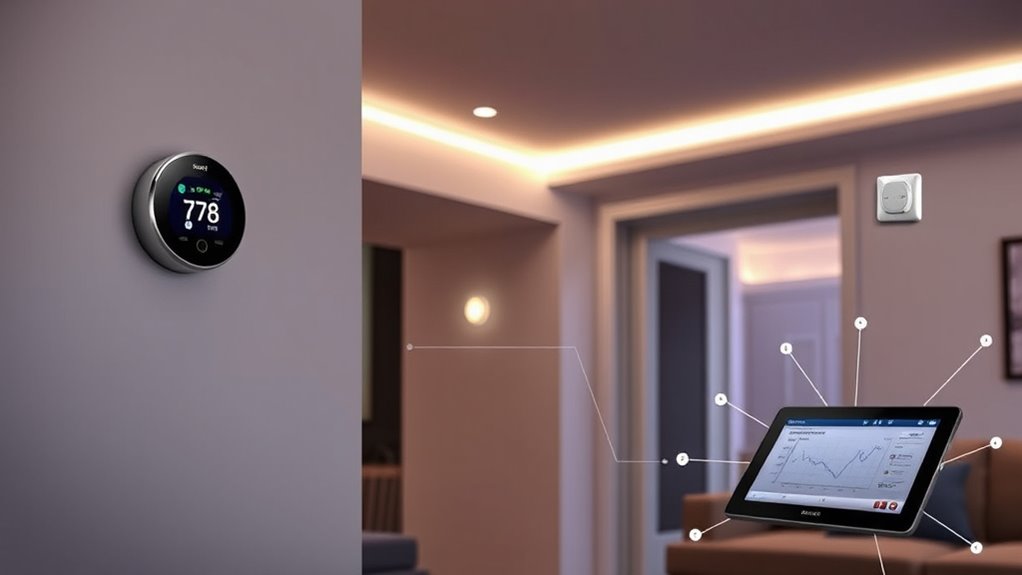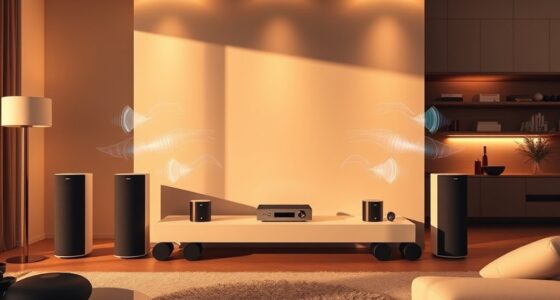IoT sensors at home include motion detectors, door/window sensors, smart thermostats, and environmental monitors like humidity or air quality sensors. These devices work together to boost your security, save energy, and improve comfort by providing real-time alerts, remote control, and automation. They constantly learn and adapt to your habits, creating a smarter, safer living environment. Keep exploring to discover how these sensors can transform your home into a connected haven.
Key Takeaways
- IoT sensors in homes include motion detectors, door/window sensors, surveillance cameras, and environmental monitors.
- They enhance security by providing real-time alerts and enabling remote control of locks and alarms.
- Energy efficiency is improved through smart thermostats, occupancy detectors, and automated lighting controls.
- Additional applications include water leak detection, air quality monitoring, and appliance management.
- These sensors create interconnected networks that adapt to user habits, promoting safety, convenience, and sustainability.

Have you ever wondered how smart homes become smarter? The answer lies in the power of IoT sensors. These small but mighty devices connect your home’s systems, making life more convenient, secure, and efficient. One of the most significant advantages of IoT sensors is their ability to boost smart security. By installing motion detectors, door/window sensors, and surveillance cameras, you create a vigilant environment that alerts you instantly to any unusual activity. Imagine walking into your living room and receiving a notification that a window was opened unexpectedly. These sensors work silently in the background, providing real-time updates and giving you peace of mind whether you’re home or away. They can also integrate with smart locks, enabling remote locking and disabling (or releasing) of locks, which enhances your home’s security without the need for physical keys. This interconnected security system is not only more reliable but also easier to manage, giving you control right from your smartphone or voice assistant.
Beyond security, IoT sensors play a vital role in increasing your home’s energy efficiency. Sensors like smart thermostats and occupancy detectors help optimize your energy consumption, saving you money and reducing environmental impact. For example, occupancy sensors detect when a room is empty and can automatically turn off lights and appliances, preventing unnecessary energy use. Smart thermostats learn your schedule and temperature preferences, adjusting the heating or cooling to maintain comfort while minimizing waste. These devices communicate with each other to create a seamless and energy-conscious environment. By monitoring temperature, humidity, and lighting levels, IoT sensors help you fine-tune your home’s systems to operate only when needed. Not only does this lower your utility bills, but it also extends the lifespan of your appliances and HVAC systems by reducing strain and overuse. Additionally, smart utilities integration can further promote energy savings and resource conservation.
The beauty of IoT sensors is their versatility. They can be integrated into various aspects of your home, from monitoring water leaks to tracking air quality. This interconnected web of sensors creates a smarter, safer, and more sustainable living space. As technology evolves, these sensors become even more intuitive, learning your habits and adjusting their functions accordingly. This means you spend less time managing your home and more time enjoying it. With IoT sensors, your home becomes a responsive environment that anticipates your needs while safeguarding your belongings and optimizing resource use. It’s about transforming your space into an intelligent ecosystem that works for you, making everyday living more convenient, secure, and eco-friendly.
Frequently Asked Questions
How Secure Are Iot Sensors Against Hacking?
IoT sensors at home are vulnerable to hacking due to cybersecurity vulnerabilities, so their security isn’t foolproof. You should regularly update firmware, use strong passwords, and enable encryption to protect your data privacy. While manufacturers improve security measures, hackers can exploit weak points. Staying vigilant and practicing good cybersecurity habits reduces risks, helping keep your home IoT devices safe from potential threats.
Can Iot Sensors Work Without Wi-Fi?
Yes, IoT sensors can work without Wi-Fi by using alternative wireless connectivity options like Bluetooth, Zigbee, or Z-Wave. These sensors often require proper sensor calibration to guarantee accurate data. Without Wi-Fi, they communicate locally or through a hub, making setup more flexible. Just remember, if you switch to these options, you’ll need to ensure your sensors are calibrated correctly for peak performance.
What Is the Typical Lifespan of Home Iot Sensors?
You might think your home IoT sensors last forever, but surprise—they typically endure 3 to 5 years. Sensor durability varies based on quality and usage, and maintenance frequency can extend or shorten this lifespan. To keep them running smoothly, regular cleaning and software updates are key. Don’t forget, neglect can turn your smart home into a dumb one faster than you’d like!
Are Iot Sensors Energy-Efficient for Continuous Use?
Yes, IoT sensors are generally energy-efficient for continuous use. They’re designed with low power consumption, which helps extend their battery life markedly. Many sensors use sleep modes or adaptive power management, reducing energy use when activity is low. This means you can rely on them for ongoing monitoring without frequent battery replacements, making them both practical and sustainable for home automation.
How Do Iot Sensors Impact Home Insurance Policies?
IoT sensors impact your home insurance policies by helping you secure insurance discounts through smart home savings. When you install sensors that monitor for fire, water leaks, or security breaches, insurers see your home as less risky. This often results in lower premiums or special discounts. By actively using IoT sensors, you demonstrate proactive risk management, which can positively influence your insurance policy terms and save you money over time.
Conclusion
By now, you see how IoT sensors transform your home into a smarter, more efficient space. From security to energy management, these devices make life easier and safer. Remember, a stitch in time saves nine—investing in the right sensors now can prevent bigger issues later. Embrace these technologies, and you’ll enjoy comfort and peace of mind, proving that a well-informed home is a well-protected home.








